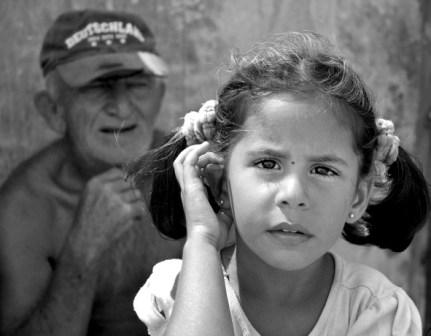Water & the Singing Frog
By Dalia Acosta

BAGUANOS, Cuba, July (IPS) – Canta Rana (literally “Frog Croaks”) might seem like a simple neighborhood of this municipality of the eastern Cuban province of Holguín, but it is much more. There, at its highest point – which allows one to view the entire town and the sugar refinery tower – ascends a tank marked by rust, time and the shortage of water.
Area residents had hoped to turn the page and forget the severe drought that parched the region for almost a decade, but they cannot. Its memory remains in the dry wells, the deterioration of the water distribution system (which always depended on the sugar industry, but used to be efficient), and in the threat of future dry spells.
“Every so often this tank bursts some place. The last time the water pressure forced it to flood my house, leaving it full of sand,” said Sheila Hidalgo, 39, a Canta Rana resident whose house is situated a few yards from the distribution tank that has not undergone thorough maintenance in nearly 10 years.
“We can’t keep depending on the refinery for water. People are dying for the sugar milling season to end, when it should be the other way around; the sugar harvest should be a time of splendor for these people,” commented Hidalgo, a specialist with the National Tax Office in town.
The water, which flows down from Canta Rana and is distributed by gravity to the entire community, is in such short supply that it barely reaches some families due to the lack of pressure. The rest of the population receives the precious liquid in water trucks about every seven days; in addition, the government ensures the supply of drinking water at 46 locations.
To the government efforts are also added those of self-employed workers, who haul water from nearby wells that they’ve been able to bring back to life.
Báguanos, a typical rural municipality located 430 miles from Havana, has two urban centers: a town of the same name, with 8,800 inhabitants; and Tacajó, with 10,030 residents. In addition, there are 102 rural communities, which bring the area’s total population to 55,000.
The municipality’s main economic resources derive from the sugar industry and several agricultural firms, historically affected by the poor hydrographic potential of the province, noted official sources.
Although the government’s construction of the Charco Largo de Tacajó Reservoir, with a capacity of 20.5 million cubic meters of water, assures water for the urban hubs of the municipality, the appropriate infrastructure still does not exist for the quality distribution of that resource to the public.
Only 12.5 million cubic meters of water in the reservoir can be used for human consumption. The water pumped from the reservoir goes into the “tank of a million,” located in a section of the Ramón López Agro-industrial Complex, and from there flows to the Canta Rana neighborhood.
“Eleven liters per second are pumped from the reservoir, with four liters per second going into water trucks and the remaining seven per second going into the tank. Priority is given to the supply of water for the refinery’s cooling system, leaving the general population served by pumping for only two hours a day,” explained Jose Ramon Alvarez, an operations technician for the local water system.
The availability of the liquid doesn’t guarantee the needs of the refinery, which requires 25 to 30 liters per second during the sugar harvest (extending from November to June). Much less of that quantity goes to the town’s 8,800 residents, who are constantly seeking ways to address this shortfall.
“A good number of people who come to my office do so because of this problem. The complaints are constant, which is logical,” said Delfina Alvarez, who has spent 22 years working in that area attending the public in the municipal office of the Cuban Communist Party.
A Supportive Response
Reducing the dependence on the refinery seems to be one of the most important purposes of a local development project undertaken by local authorities and the National Institute of Hydraulic Resources (INRH), with the support of the Spanish Agency of International Cooperation for Development (AECID).

With the stated aim of improving the quality of water for the development of the municipality in its entirety, the project will directly benefit some 20,000 people in the communities of Báguanos and Tacajó, and will indirectly impact on the quality of life in the rural communities.
In essence, this is responding to the need for better distribution and a more efficient use of clean water through several actions: the rehabilitation of the local water system (by installing a concrete tank with a capacity of 1,800 cubic meters of water), and the installation of a purification plant and new high-density polyethylene piping.
The plant “will treat surface water at a purification rate of up to 60 liters per second, which is considered sufficient for current needs in the Holguín region,” said National Institute of Hydraulic Resources sources, who described the present situation in the municipality of Báguanos as “peculiar” in the provincial context.
With a population of more than one million people, the eastern Cuban province of Holguín guarantees drinking water to 98.7 percent of its inhabitants, though it has one of the country’s lowest recorded rates of quantity of water available: 495 liters per person, according to 2006 figures from the National Statistics Office (ONE).
Sources at ONE assured that 95.6 percent of Cuban’s 11.2 million citizens had access to drinking water in 2005. A total of 78.8 percent of the population has home connections, while 5.4 percent receive water piped in by truck, and 15.8 percent sought it at a maximum distance of 300 meters from their homes.
The second report by Cuba on the monitoring of its Development Objectives for the Millennium (ODM), approved by the United Nations General Assembly in 2000, assured that as early as 1995 the Caribbean island had already fulfilled its outlined goals in terms of access to clean drinking water.
Potable water was accessible to 98.2 percent of those Cubans living in urban communities and to 87.3 percent of those in rural areas, states the study. The most adverse situations were those reported in the eastern part of the island, where the greatest efforts are being concentrated by the National Water and Health Program and international cooperation agencies.
To help address that situation, the new Báguanos water system project was proposed, which in addition to guaranteeing access to clean water, promises to make a positive impact on the economic diversification of the province and on employment possibilities in various sectors, among these being the production of high-density polyethylene piping.
Once the construction phase is completed and the effective start-up of the entire system is ensured – in about four years – the problem will move to the efficient use of available hydraulic resources, which will always depend on climate fluctuations, rain cycles and drought periods.
“We plan to work with a system of metric meters to see if it does or doesn’t make sense to measure the quantity of water, and if there are other possibilities for increasing people’s awareness of the need to conserve that resource,” explained hydraulic engineer Sergio Pérez, the coordinator of Clean Drinking Water office AECID in Havana.
It’s a Health Problem
“The water that is pumped from here is not chlorinated,” said Alvarez, who pointed out flows accumulate in the tank of the Ramon Lopez Peña Refinery. To prevent the consumption of that water, up to 20 liters of potable water are guaranteed to each nuclear family at a token cost of one Cuban centavo per liter (much less than one penny USD).
Closely tied to several UN Millennium objectives, the access to quality water impacts the level of a population’s health through its relationship to the transmission of certain infectious illnesses, such as diarrhea, but also on personal and family hygiene.
“In Báguanos, there are no reports of high rates of acute diarrhoeic illnesses, but the quality of the water indeed seriously affects the female population, especially pregnant women,” assured Laine Caceres, an obstetrician who has worked in the community for 12 years.
“A vaginal infection caused by a fungus known as monilia is closely associated with water that is used in the bathroom; it can lead to threats to birth within 37 weeks of pregnancy, can cause post-childbirth complications and led to underweight births,” the specialist added.
She estimates that water quality has become the cause of the principal health problems in this area of Cuba.
The promotion of educational campaigns appears to be among the needs of those people who, when they receive water through a home connection, use it for consumption, even though they know that it doesn’t meet the necessary standards. “Not all people have the same sense of hygiene,” commented Sheila Hidalgo.
“When there is water from the reservoir, people hardly ever come. They prefer to use water provided by pipes to coming here,” said Ziomara Proenza, 57, who along with her husband is in charge of one of the water sale-points set up by the local government in the Canta Rana neighborhood.
A Havana Times translation of the original article published in Spanish by IPS.





